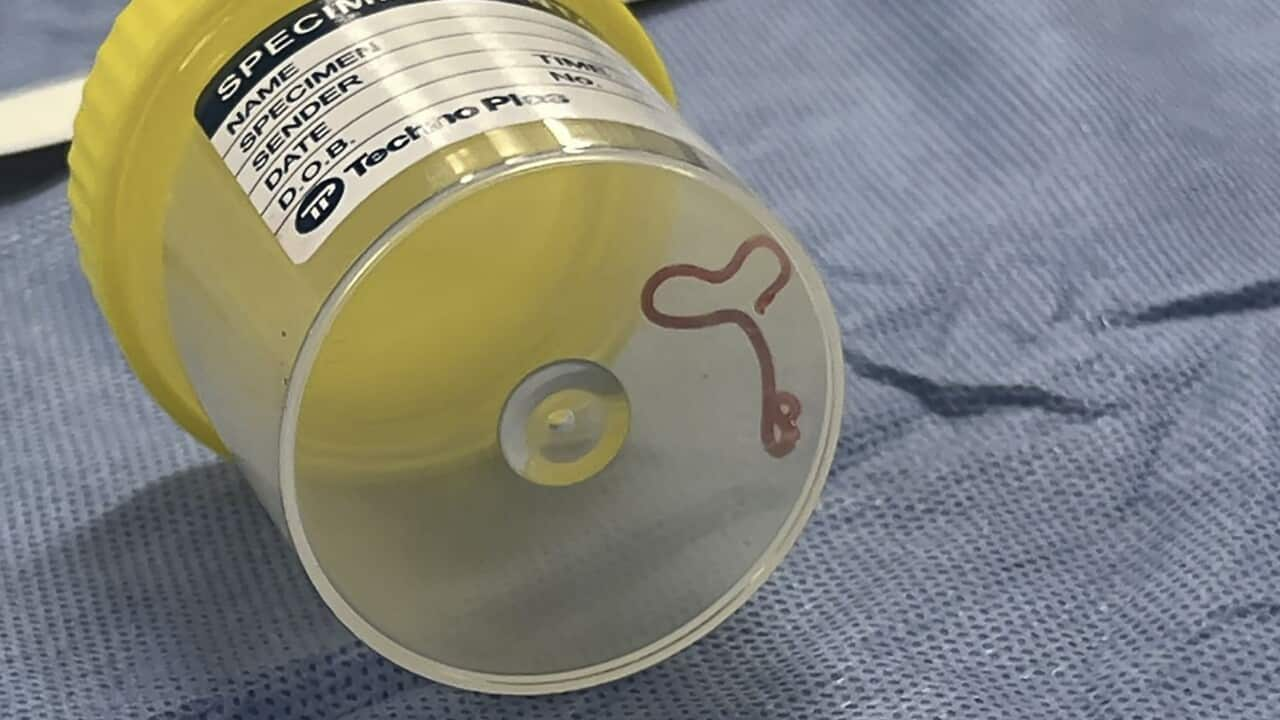TRANSCRIPT
Janice Petersen 0:00
Doctor Senanayake, thanks so much for joining us. Can you take us back to this particular day when your neurosurgeon colleague asked for your advice?
Sanjaya Senanayake 0:09
Yes. So I was on for the wards at the hospital. So to provide infectious diseases, advice for other teams who had complicated patients, and I got a call from one of my colleagues in the lab, the microbiology lab saying that the neurosurgeons had just removed a live eight centimeter worm from a patient's brain and that our input would definitely be needed. So obviously, that is not the type of call you get every day. So we obviously, were racing around to look at the worm, try and identify it and work out what infection this person had.
Janice Petersen 0:48
What did you do from there because I mean, this is unprecedented, isn't it?
Sanjaya Senanayake 0:53
So this is the first documented human infection with this parasite. So you're quite right, we had nothing really to go on. There are certain parasites that are known to infect humans that can do things like this, but this particular one had never done had never done so at least been documented to do so. So therefore, it was a matter of trying to work out what the most likely parasite was my colleague in the microbiology lab, who's also co author on the paper, she also had the foresight to involve a scientist at CSIRO, who was an expert in parasitology. In the animal world, and Canberra being a small place, we were able to actually send him the live wriggling worm directly, and he was able to look at it. And with his decades of experience, he was able to nail the diagnosis. He looked at the worm and said, This is a third stage larvae of offered a scar is Roberti. Now we then went on to do molecular studies on the worm to confirm that but he was right. So that's how this all came about. But this there was a helter skelter of activity, once the worm had been discovered trying to work out what it was. So we could nail the diagnosis and treat the patient well.
Janice Petersen 2:10
And so our understanding now is that it came from a Carpet Python, how on earth then did that end up in this poor woman's brain?
Sanjaya Senanayake 2:20
I know exactly. So to understand that we probably need to understand what normally happens with this parasite. And what normally happens is this, it normally lives in the Carpet Python. And in the Python feces, the eggs of the parasite will also be found, and small mammals and marsupial's while consuming vegetation or other things, which are contaminated with Python and feces and the parasite eggs will consume the parasite eggs, and the parasite will further develop in those animals. And then a snake Carpet Python will come along and consume one of those marsupials or small mammals. And then a more mature stage of the parasite will be in the snake, and the lifecycle will complete itself. So that's what normally happens. But what we think has happened here is that Python feces have contaminated Warrigal greens, which are a native grass that is seen all along the east coast in Australia. And the patient has picked this up her hands have become contaminated with the parasite eggs, and this is how it's gotten inside of her. And then from there, the parasites developed, but she's an accidental host. She's not humans are not hosts where this would normally occur.
Janice Petersen 3:46
Some people might unkindly say that there are plenty of snakes in Canberra, Dr. But how would you advise people to avoid this sort of thing from happening again?
Sanjaya Senanayake 3:57
Yeah, no, no, no, this patient was treated in Canberra hospital. She's from southeastern New South Wales, so not Canberra itself. But what we would say is this. Now, this is not a common occurrence. This is something that's likely to be unusual, or rare, but it has happened. And we know that there have been 30 new infections in the last 30 years, and three quarters of them are infections that have spilled over from the animal world, into the human world. And as we encroach on hemp, more animal habitats with our burgeoning human population, we're likely to see more interactions lead to more of these novel infections. So though unusual, more of these infections are likely to happen. Therefore, simple common sense advice. If you forage for plants to either eat, or to just decorate the insides of your home, just wash your hands afterwards, that will reduce the risk of of getting infected. And if you consume them, make sure you cook them well
Janice Petersen 5:03
and understand ik Can you tell us an estimate of how long you think this parasite was in this woman's brain? And how she doing now?
Sanjaya Senanayake 5:12
Yeah, well look to, I guess answer the second question soon after the worm was removed from the brain, we started her on anti parasitic treatment, and she very quickly left hospital and hasn't been back to hospital since. So she's remained in the community. But obviously, because it's such a novel unusual infection, we're keeping a close eye on her and keeping in touch with her in terms of how long the the lava or the worm was in the brain, it's really hard to know, we certainly know that in rats, this particular parasite, the third stage larva, which is the one that was found in her brain has been shown to live for at least four years. So it can hang around in a mammalian body for a very long time. It may only recently have or relatively recently gone into the brain, which led to those symptoms over a few weeks or months, and started off elsewhere in the body. But we just don't know,
Janice Petersen 6:11
I'm almost too scared to ask Dr. But what was it feeding on? During that time,
Sanjaya Senanayake 6:18
you have to remember with parasites, I mean that the reason they're parasites is they don't go about killing us. They live inside us and just take enough to keep themselves going. But without disrupting us too badly because they need us need us alive. But so they just munching on proteins and and other things they find anywhere in the body as to this particular parasite because it's never infected a human before, it is hard to know. But thankfully, it was removed from this lady's brain and hopefully with the subsequent anti parasitic treatment, any other worms living in her body would have been killed when he
Janice Petersen 6:58
was studying to be an infectious diseases expert. Did you ever think you'd come across a case like this,
Sanjaya Senanayake 7:04
you know, is the shorter? And we we know in infectious diseases, I've just said that there are new infections appearing in the world all the time, but it's a big world. And to think that you'd actually be part of a team that identifies a new infection never seen before in a person. Yeah, you don't think that'll happen? So I'm in the twilight of my career, and I never thought it would happen. But look, it has, but most importantly, for the patient's sake, we've identified it and hopefully treated her so she can go and live a normal life.
Janice Petersen 7:38
I mean, this is an interesting topic to be at, we're leading on but just how much international interest is there in this sort of development?
Sanjaya Senanayake 7:47
Oh, look, I think there's been a lot of interest, obviously, with this particular story that the yuck factor, I think, has captured a lot of attention and living worm taken from someone's brain. But as I said beforehand, even without that the fact that this is another new infection that's appearing, that the pandemic type viruses that appear are from the animal world coming to the human world, it just shows we have to be vigilant. So health authorities really need to make sure that we've got good surveillance systems in place. Australia really does need to have a Centers for Disease Control. So it's very important to keep that on the radar Even though COVID is becoming less and less of a problem. And in other parts of the world. They have snakes with this parasite in it. So hopefully, this will increase awareness around the world and to identify other cases in people so they can be treated properly.
Janice Petersen 8:44
Dr. Senanayake. Thank you so much for your time today and let's hope you never have a day like that again.
This timecoded transcript was created using machine learning technology.













